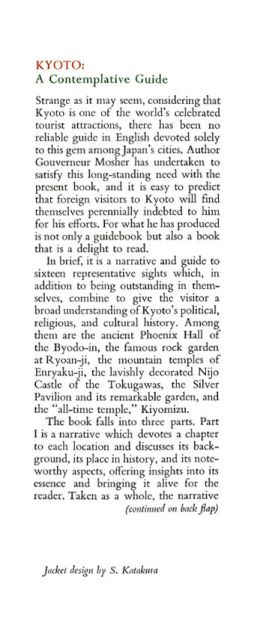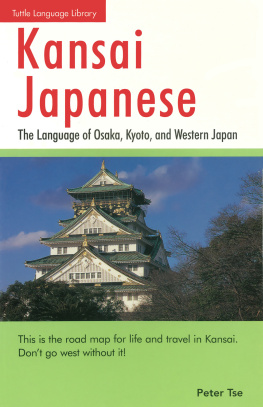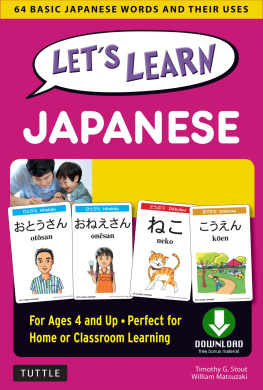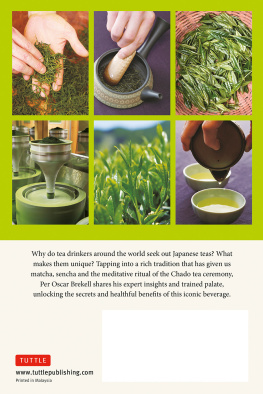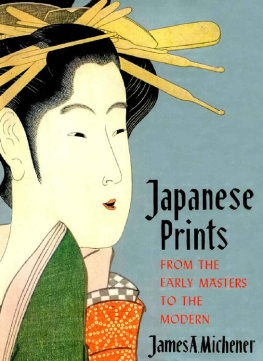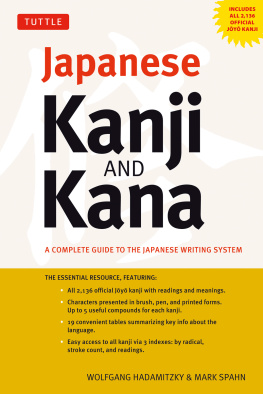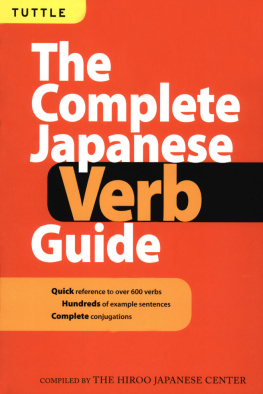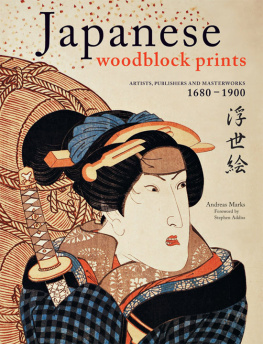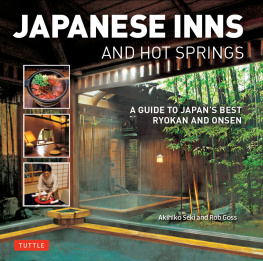Acknowledgments
I WISH to acknowledge the generous efforts of the following persons, all of whom contributed markedly to the possibility of this book's being written: Ishida Eiji, professor at Kyoto Prefectural University; Shimojima Masao; Okubo Hiromasa; Fujitani Kiyoshi; Terasoma Shigeo; Sakabe Hiroshi. Among the priests and personnel of many temples who gave me their patient assistance, I owe special thanks to Matsumoto Daien of Kiyomizu-dera, Akamatsu Enzui of Enryaku-ji, and my good friends Kodama Kogetsu of Eifuku-ji in Osaka and Okamoto Ryuen of Enryaku-ju For hours of work and helpful suggestions I wish to thank John Philip Emerson and Austin M. Francis, Jr. I have a particular debt to Philip Yampolsky, whose translation of Daitoku-ji's own guide forms the backbone of the information on that temple appearing in Part II, and to Nagai Atsuko, who sacrificed much of her free time to my research for this book and provided many good ideas. Finally, I wish to thank Ralph Friedrich for editing the book with tireless patience, energy, and interest.
In the realm of printed sources, I wish to acknowledge the special help provided by the following, especially as indicated:
A. Akiyama: Pagodas in Sunrise Land, Tokyo, 1915 (Enryaku-ji) C. R. Boxer: "Hosokawa Tadaoki and the Jesuits, 15871645, Transactions and Proceedings, Japan Society, London, Vol. XXXII, 1934-35 (Daitoku-ji)
H. H. Coates and R. Ishizuka: Honen the Buddhist Saint, Kyoto, 1949 (Enryaku-ji, Sanzen-in, Anraku-ji and Honen-in, Daigo-ji, and others)
R. T. Paine and A. Soper: The Art and Architecture of Japan, London, 1960 (Enryaku-ji, Daigo-ji, Nijo-jo)
E. Papinot: Historical and Geographical Dictionary of Japan, Yokohama, 1909 (nearly all subjects, especially personalities)
R. A. B. Ponsonby-Fane: The Imperial House of Japan, Kyoto, 1959 (Shugaku-in Rikyu)
______: Kyoto, the Old Capital of Japan, Kyoto, 1956 (Shinsen-en, Ginkaku-ji, Nijo-jo, Shugaku-in Rikyu, Nijo jinya [Temmei Fire], and others)
A. L. Sadler: The Ten Foot Square Hut and Tales of the Heike, Sydney, 1928 (Uji Jakko-in)
G. B. Sansom: Japan, A Short Cultural History, New York, 1943 (Daigo-ji)
R. F. Sasaki: Rinzai Zen Study for Foreigners in Japan, Kyoto, 1960 (Daitoku-ji)
______: Zen: A Religion, Kyoto, 1958 (Daitoku-ji)
D. T. Suzuki: Japanese Buddhism, Tokyo, 1938 (Daitoku-ji)
M. Tatsui: Japanese Gardens, Tokyo, 1936 (Ginkaku-ji)
W. Watson: Sculpture of Japan, New York, 1959 (Enryaku-ji, Byodo-in, Daigo-ji)
I made use of pamphlets and other materials provided by the following places:Enryaku-ji, Sanzen-in, Byodo-in, Daitoku-ji, Jodo-in, Ryoan-ji, Daigo-ji, Nijo-jo, Shugaku-in Rikyu, Nijo Jinya, Kiyomizu-dera. Shugaku-ins new booklet in English is an outstanding contribution; most of the others are in Japanese.
APPENDICES
Appendix I: Japanese Art Periods
The following is the generally accepted breakdown of the major periods of Japanese art:
Archaic | -552 | Pre-Buddhist, native |
Asuka | 552-645 | Buddhism arrives, Korean influences |
Nara | 645-794 | Capital at or near Nara, Buddhism establishes itself |
Early Heian | 794-897 | Chinese influences | } | Buddhism now Supreme |
Later Heian | 897-1185 | National styles emerge |
Kamakura | 1185-1392 | The Minamoto shoguns, etc. |
Muromachi | 1392-1573 | Ashikaga shoguns, civil war |
Momoyama | 1573-1615 | Nobunaga and the Toyotomi |
Edo | 1615-1868 | Tokugawa shoguns |
Meiji-Taisho | 1868-1926 | Post-restoration, "pure" Shinto revived |
Present | 1926- | Present reign |
Note: The Nambokucho, or period of imperial schism (1336-92), is assigned to either the Kamakura or the Muromachi period and sometimes is separated from them both.
Appendix II: Glossary
a. japanese words used in the text.
biwa: a large musical instrument like a lute
chigai-dana: a set of offset or fancy shelves in an alcove
daimyo: a feudal lord or baron
fusuma: heavier sliding screens papered on both sides and usually decorated or painted; cf. shoji
geta: wooden clogs worn on the feet
ho-o: a title given to an emperor who becomes a Buddhist priest after abdicating
horai : a mythical paradise, usually imagined as a distant islandan idea originally from China
hyotan: a gourd or gourd shape, often used as a symbol
ihai: memorial tablet to a dead person, which is thought to be inhabited by his spirit
ingu: a Shinto shrine of national importance, a great shrine, such as Heian Jingu, Kyoto; Meiji Jingu, Tokyo; and the shrines at Ise
jinja: a Shinto shrine not belonging to the above group
jinya: an "encampment house," or sub-castle, e.g., Nijo Jinya
karesansui: "lacking mountain and water"a flat dry garden, usually of raked gravel or sand and rocks
ko-an: a phrase or snatch of dialogue used as a subject of meditation by Zen Buddhists
kohai: the "halo" placed behind a Buddhist image, usually in the shape of a rising flame and gilded; often very intricate and covered with minor Buddhas
koma-inu: lit., Korean dog, a general term for "Korean dogs and Chinese lions," mythical beasts whose images guard the access routes to temples and shrines
mandala: (Sk., Jap. is mandara) an intricate schematic painting of a Buddhist afterworld which attempts in a formal way to portray all aspects of the subject; prominent in the Shingon sect, and common in those sects worshiping Amida
mikoshi: a portable shrine of the type carried through the streets by crowds during festivals
mokugyo: a wooden gong, usually in the shape of a curled fat fish, sounded during Buddhist services
monzeki: a temple having an imperial abbot or an imperial person in residence; also applied to nunneries with imperial women (ama-monzeki)
Nembutsu: the phrase " Namu Amida Butsu " repeated by worshipers of the Amidist sects as the principal part of their worship (see chapter 3)
nijiri-guchi: the "wriggling-in" or "humble" entrance, a small demeaning hole through which people enter a teahouse
Noh: a form of drama characterized by the use of masks and by dance and song accompanied by instrumental music
Ojo: in the Jodo and Shin sects, birth into Amida's Paradise immediately after death; in the Shin sect, including immediate perfect enlightenment, but not in the Jodo, where enlightenment is not achieved until long after Ojo
rikyu: a detached palace, or imperial villa
samurai: a warrior or his class, esp. of the 12th to 18th centuries, during which time the class was most powerful
satori: a religious awakening or insight which is a prominent part of Zen worship and which, if achieved, comes suddenly and intuitively
sei-i-tai-shogun: "barbarian-quelling great general," a title originally conferred by the emperor upon his generals who led expeditions against the northern aborigines around a . d . 800; later assumed by generals of the Minamoto, Ashikaga, and Tokugawa families in establishing their military regimes
shiro: a castle
shogun: an abbreviation of sei-i-tai-shogun, q.v.
shoji: lightweight sliding screens usually papered with plain white paper on one side only; cf. fusuma
sorin: the metal spire of a pagoda

